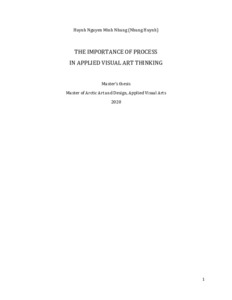The importance of process in applied visual art thinking
Huynh, Nhung (2020)
Huynh, Nhung
Lapin yliopisto
2020
All rights reserved
Tiivistelmä
Belonging to the Contemporary art movement, Applied Visual Art is a new discipline being developed by the Faculty of Art and Design at the University of Lapland and Kemi-Tornio University of Applied Sciences. It emphasizes on enhancing communal and environmental development within the local areas. The project-based framework of AVA reveals the close relationship between art and design. Thus, this research interest is based on the process- oriented characteristic of AVA project, then aims to establish a connection between the importance of a art process and a design journey.
The main research method used is Art-based action research, in which art making processes are used to develop project and framework study and the key points to be study are community art, user participations and designers’ roles. The data collected throughout different cycles of action in this research are cultural dialogues, art-based discussions and documentations, designer’s notes and visualizations. In order to obtain the data, the main approaches used in the research are contextual research, participatory design, data analysis, documentation and evaluation.
The research shows the influences of AVA’s process on adding values to the product's communication and interaction with users, thus, improving a product design journey. Moreover, it emphasizes the significance of a designer's role in an AVA project, while establishing more active directions for a designer/an art practitioner involved in project development processes. Even though there are challenges in the development work of an AVA project, such as cultural differences or objective misunderstandings, the framework proves to be sustainable in terms of themes, application and future developments. For later research and application of AVA thinking and process, the framework has the ability to grow as a tool for local communities’ development and can also be employed by designers to improve a design journey in terms of product contextual development and users research. The need for AVA framework learning and educating, thus, may increase and result in a more active and multidisciplinary working environment for artists and designers.
The main research method used is Art-based action research, in which art making processes are used to develop project and framework study and the key points to be study are community art, user participations and designers’ roles. The data collected throughout different cycles of action in this research are cultural dialogues, art-based discussions and documentations, designer’s notes and visualizations. In order to obtain the data, the main approaches used in the research are contextual research, participatory design, data analysis, documentation and evaluation.
The research shows the influences of AVA’s process on adding values to the product's communication and interaction with users, thus, improving a product design journey. Moreover, it emphasizes the significance of a designer's role in an AVA project, while establishing more active directions for a designer/an art practitioner involved in project development processes. Even though there are challenges in the development work of an AVA project, such as cultural differences or objective misunderstandings, the framework proves to be sustainable in terms of themes, application and future developments. For later research and application of AVA thinking and process, the framework has the ability to grow as a tool for local communities’ development and can also be employed by designers to improve a design journey in terms of product contextual development and users research. The need for AVA framework learning and educating, thus, may increase and result in a more active and multidisciplinary working environment for artists and designers.
Kokoelmat
- Pro gradu -tutkielmat [4897]
